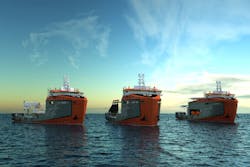Damen unveils decommissioning vessel concept design
Offshore staff
GORINCHEM, the Netherlands – Damen Shipyards Group has released a new concept design called the Damen Decommissioning Series which will specialize in three core areas of the oil and gas decommissioning sector: topsides decommissioning, offshore platform removal, and subsea cleaning and removal.
The design is based on in-house research carried out by one of the company’s undergraduate interns.
Justin Rietveld, who is studying Maritime Technology at the Rotterdam Mainport University of Applied Sciences, was offered an internship at the company. His brief was to investigate the potential niche markets for new vessel designs in the oil and gas decommissioning sector.
“This research started off with the idea of developing adecommissioning vessel based on Damen’s existing portfolio,” Rietveld said. “However, we soon found out that this market needs more.
“For example, there are many different activities within the decommissioning sector. This vessel can support a vast number of those. We have developed a concept to cover the bigger part of this new and exciting market.”
The vessel’s monohull design has a split stern; a characteristic that will come into play during platform removal operations, explained Rietveld: “This ship will be able to reverse up to a jacket, where it will be ballasted to sink below the platform. Upon deballasting, the vessel will rise up to pick up the platform.”
The preliminary estimations of the vessel’s capabilities show that it will be able to perform decommissioning of fixed platforms of up to 1,600 metric tons (1,763 tons) in weight.
The concept design also includes modular add-ons which the company said will address the possibility that the vessel will not be solely active in the decommissioning market. This versatility will ensure that owners can optimize productivity: bridging the potential gap between decommissioning contracts with other roles.
These modular additions to the existing design include the temporary installation of a crane or a helideck. Functionality can be further boosted with the addition of accommodation modules to increase personnel capacity.
Another option will be the addition of a temporary platform to create a solid stern. The subsequent increase in deck capacity could be used for transporting and installing monopiles and foundations for the offshore wind industry.
07/29/2016
